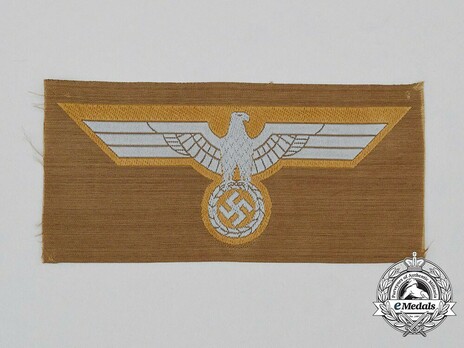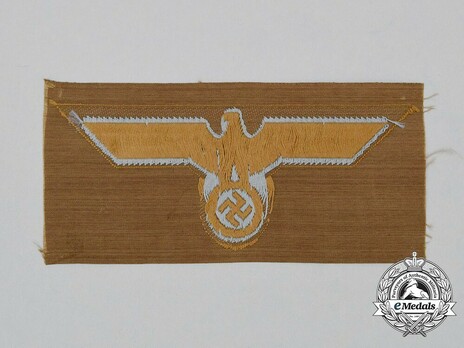Afrikakorps Heer NCO/EM's Breast Eagle (Rectangular Backing version)
CATEGORY: Version
SKU: 23.GOR.03.02.01.01.003.000
Estimated market value:


Estimated market value:
mint and unissued Wehrmacht Heer (Army) DAK (Deutsches Afrika Korps/German Africa Corps) EM/NCO breast eagle; constructed of densely woven BeVo style machine embroidery in grey and tan threading; on a matching tan rayon backer; measuring 114 mm x 53 mm; mint and unissued condition.
During the Second World War, German troops stationed in northern Africa are generally referred to as the Afrikakorps. Technically, this is not entirely correct, since some German units operating in Africa were not actually part of the DAK (Deutsches Afrikakorps), and some units of it were, in fact, Italian ones. However, for the purpose of collecting so-called “tropical” uniforms and insignia, collectors have simplified the meaning of the term.
The first German troops were sent to northern Africa in February of 1941, to support their Italian allies against the British. The climate of the African continent made it necessary to wear specialised uniforms and gear that not only supported the soldiers in serving in a hot and arid environment, but also helped them in blending in with the landscape, which, in general, presented itself as brown, olive, khaki, or sand/tan in colour. Worn over long periods of time under the blistering desert sun, some uniforms were eventually bleached to white or off-white. Uniforms and insignia in these colours are often referred to as “tropical”, and it is worth noting that they weren’t just worn by members of units stationed in Africa, but in the entire Mediterranean theatre of war, including southern France, Italy, the Balkans, and Greece, as well as in southern Russia during the summer months. Tropical uniforms were worn by members of all three branches of the Wehrmacht: the Heer (army), the Kriegsmarine (navy), and the Luftwaffe (air force). Members of the Waffen-SS stationed in southerly regions also wore tropical-style uniforms, and even though they technically have no connection to the DAK, all tropical uniforms and insignia of all branches of the German military are listed here.
A national emblem in the form of a breast eagle was worn, on most pieces of clothing that bore it, on the right breast. The Third Reich style insignia was introduced on February 17, 1934. Early examples were embroidered, while later examples were often machine-woven in the so-called BeVo style. Examples for privately purchased tunics, dress tunics, or for officers were often hand-embroidered.
Next to the hand-embroidered examples, officers would also wear silver or aluminum machine-woven eagles. Those worn by men of General ranks were in gilt. Early examples were made of gilt bullion wire, later examples of golden-yellow celleon wire. NCOs (non-commissioned officers) and EMs (enlisted men) were allowed to wear the officer’s aluminum machine-woven or hand-embroidered breast eagles on privately purchased tunics.
Tropical breast eagles came on a brown or tan cloth backing. Those were either rectangular, triangular, or had no backing and were therefore just a cut-out version.

Comments
Sign in to comment and reply.


Scroll Top